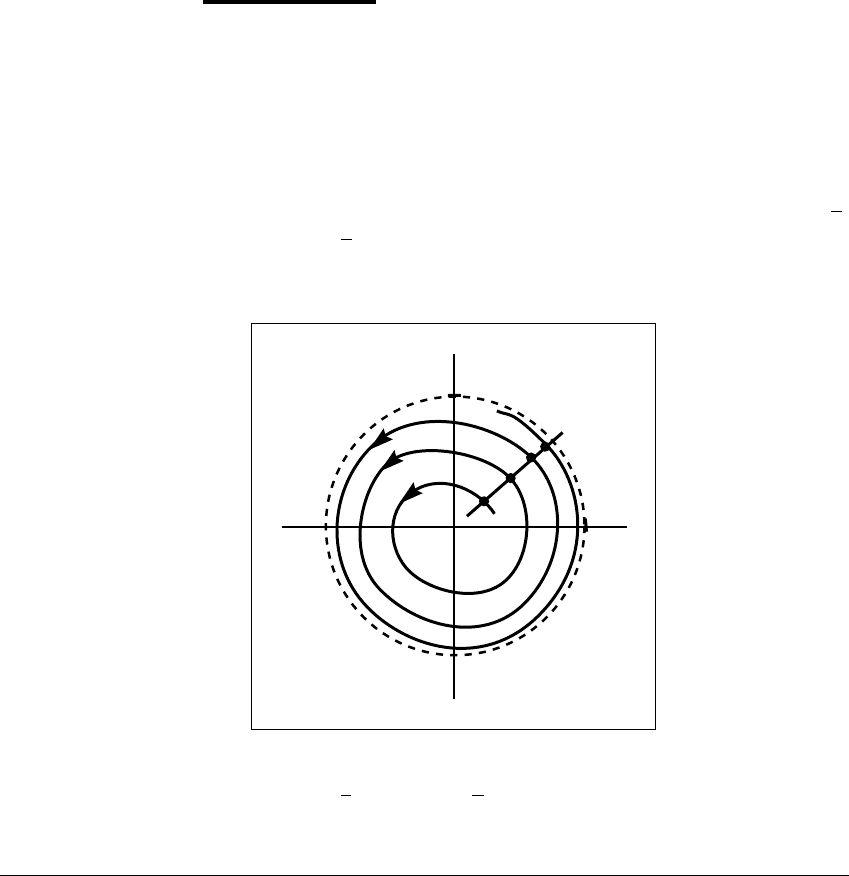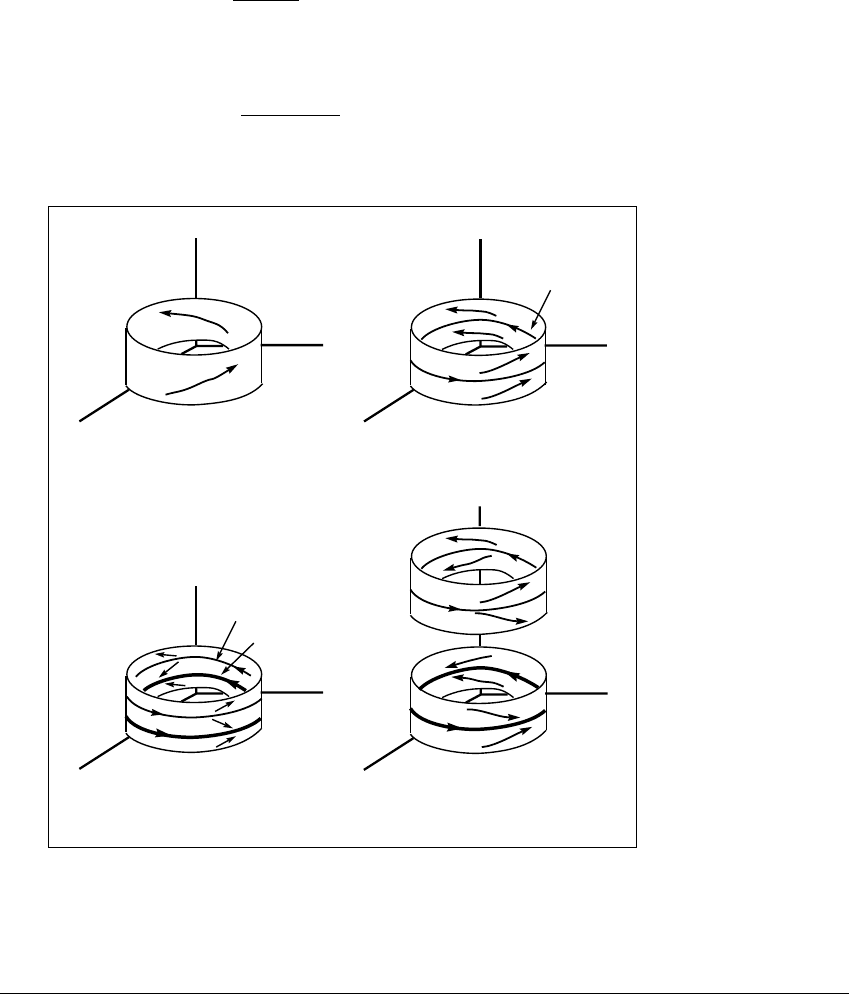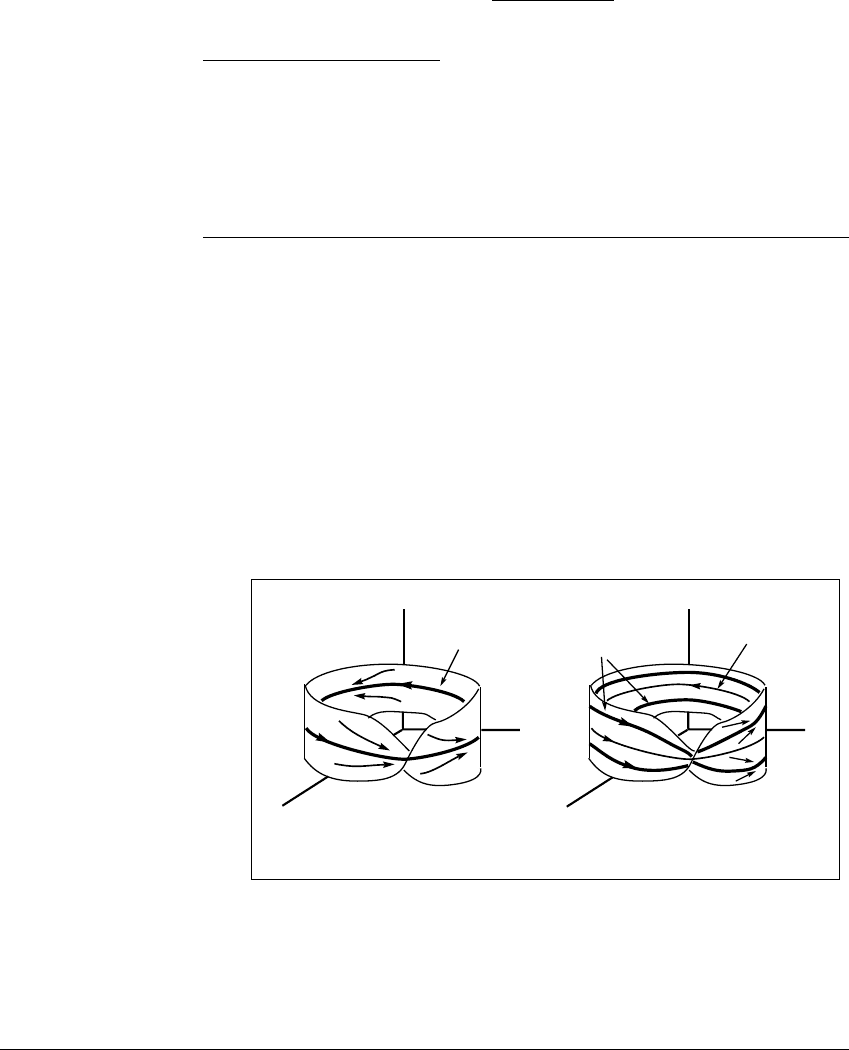Alligood K., Sauer T., Yorke J.A. Chaos: An Introduction to Dynamical Systems
Подождите немного. Документ загружается.


B IFURCATIONS
If all the multipliers of
␥
are inside (respectively, outside) the unit circle in
the complex plane, then
␥
is called an attracting (respectively, repelling) periodic
orbit. If
␥
has some multipliers inside and some multipliers outside the unit circle,
then
␥
is called a saddle periodic orbit.
Finding multipliers of a periodic orbit is largely accomplished through com-
putational methods, since cases in which a Poincar
´
e map can be explicitly deter-
mined are rare. One such case follows.
E XAMPLE 11.18
Let
˙
r ⫽ br(1 ⫺ r) (11.10)
˙
⫽ 1
where b is a positive constant, and (r,
) are polar coordinates. Since
˙
r ⫽ 0when
r ⫽ 1, the unit circle r ⫽ 1 is a periodic orbit. A segment L of the ray
⫽
,
(any fixed angle
will suffice), serves as the domain of a Poincar
´
e map. Figure
11.20 illustrates one orbit 兵r
0
,r
1
,r
2
,...其 of the Poincar
´
e map for the limit cycle
1
1
L
r
0
r
1
r
2
Figure 11.20 Poincar
´
e map for a limit cycle of a planar system.
The system
dr
dt
⫽ 0.2r(1 ⫺ r),
d
dt
⫽ 1, has a limit cycle r ⫽ 1. The line segment L
is approximately perpendicular to this orbit. Successive images r
1
,r
2
,...,of initial
point r
0
under the Poincar
´
e map converge to r ⫽ 1.
480

11.7 BIFURCATIONS IN DIFFERENTIAL E QUATIONS
r ⫽ 1 of (11.10) with b ⫽ 0.2. Using the fact that a trajectory returns to the
same angle after 2
time units, we separate variables in (11.10), and integrate a
solution from one crossing, r
n
, to the next, r
n⫹1
of L:
r
n⫹1
r
n
dr
r(1 ⫺ r)
⫽
2
0
bdt ⫽ 2
b.
Evaluating the integral on the left (by partial fractions), we obtain
r
n⫹1
(1 ⫺ r
n
)
r
n
(1 ⫺ r
n⫹1
)
⫽ e
2
b
.
x
y
z
x
y
z
C
(a) (b)
x
y
z
C
1
C
2
x
y
z
C
2
C
1
(c) (d)
Figure 11.21 A saddle-node bifurcation for a three-dimensional flow.
(a) The system begins with no periodic orbits. (b) The parameter is increased, and
a saddle-node periodic orbit C appears. (c) The saddle-node orbit splits into two
periodic orbits C
1
and C
2
, which then move apart, as shown in (d).
481

B IFURCATIONS
Then, solving for r
n⫹1
,
r
n⫹1
⫽
r
n
e
2
b
1 ⫺ r
n
⫹ r
n
e
2
b
. (11.11)
✎ E XERCISE T11.15
(a) Show that for b ⬎ 0, the sequence 兵r
n
其, as defined by (11.11),
converges to 1 as n →
⬁
.
(b) Find the Floquet multiplier of the orbit r ⫽ l.
(c) For which values of b is this orbit stable?
Through the Poincar
´
e map and time-T map, we can exploit the bifurca-
tion theory developed for maps to study the bifurcations of periodic orbits of
parametrized differential equations. For v 僆 ⺢
n
and a scalar parameter a,let
˙v ⫽ f
a
(v) (11.12)
denote a one-parameter family of differential equations. As before, a periodic orbit
␥
of (11.12) is classified as “continuable” or a “bifurcation” orbit, depending on
whether v
0
on
␥
is a locally continuable or bifurcation orbit for the one-parameter
continuation of the Poincar
´
emapT or time-T map F
T
.
x
y
z
C
1
x
y
z
C
1
C
2
(a) (b)
Figure 11.22 A period-doubling bifurcation for a three-dimensional flow.
The system begins with a periodic orbit C
1
, which has one multiplier between 0
and ⫺1, as shown in (a). As the parameter is increased, this multiplier crosses ⫺1,
and a second orbit C
2
of roughly twice the period of C
1
bifurcates. This orbit wraps
twice around the M
¨
obius strip shown in (b).
482

11.8 HOPF B IFURCATIONS
Figure 11.21 shows a saddle-node bifurcation of periodic orbits, and Figure
11.22 shows a period-doubling bifurcation. Recall that at a saddle-node bifurca-
tion orbit, the linearized map has an eigenvalue of ⫹1. In the case of a flow, a
multiplier of the periodic orbit must be ⫹1. For a period-doubling bifurcation,
the orbit must have a multiplier of ⫺1.
✎ E XERCISE T11.16
After a period-doubling bifurcation, are the periodic orbits linked or un-
linked? (See, for example, the orbits C
1
and C
2
, as shown in Figure 11.22(b).)
✎ E XERCISE T11.17
Show that a one-parameter family of autonomous plane differential equa-
tions cannot contain any period-doubling bifurcation orbits.
11.8 HOPF BIFURCATIONS
Saddle-node and period-doubling bifurcations are not the only ways in which
periodic orbits are born in one-parameter families. There is one more “generic”
bifurcation. In an Andronov-Hopf bifurcation (often shortened to Hopf bifurca-
tion), a family of periodic orbits bifurcates from a path of equilibria.
E XAMPLE 11.19
(Hopf bifurcation.) Let
˙
x ⫽⫺y ⫹ x(a ⫺ x
2
⫺ y
2
)
˙
y ⫽ x ⫹ y(a ⫺ x
2
⫺ y
2
) (11.13)
for x, y, and a in ⺢. The bifurcation diagram for this system is illustrated in Figure
11.23. Verify that for a ⬎ 0, there are periodic solutions of the form
(x(t),y(t)) ⫽ (
a cos t,
a sin t).
In polar coordinates, equations (11.13) have the simple form
˙
r ⫽ r(a ⫺ r
2
)
˙
⫽ 1. (11.14)
483

B IFURCATIONS
y
x
a
v
a
(a) (b)
Figure 11.23 Supercritical Hopf bifurcation.
(a) The path 兵(a, 0, 0)其 of equilibria changes stability at a ⫽ 0. A stable equilibrium
for a ⬍ 0 is replaced by a stable periodic orbit for a ⬎ 0. (b) Schematic path diagram
of the bifurcation. Solid curves are stable orbits, dashed curves are unstable.
For each a, the origin r ⫽ 0 is an equilibrium of (11.14). When a is negative,
˙
r is negative, and all solutions decay to 0. For each a ⬎ 0, there is a nontrivial
periodic solution r ⫽
a. A path of periodic orbits bifurcates from v at a ⫽ 0. In
this example, notice that there is exactly one periodic orbit for each planar flow
when a ⬎ 0.
Common to bifurcations we have discussed, the family of periodic orbits
bifurcates from a path of equilibria that changes stability at the bifurcation point.
In this case, the equilibria go from attractors to repellers. We picture this planar
nonlinear case in Figure 11.24. The variation in parameter brings about a small
change in the vector field near the equilibrium, causing a change in its stability.
Meanwhile, the vector field outside a small neighborhood N of the equilibrium
remains virtually unchanged, with the vector field still pointing in towards the
equilibrium. Orbits within N are trapped and, in the absence of any other equi-
libria, must converge to a periodic orbit.
Definition 11.20 Assume that
v is an equilibrium at a ⫽ a for the one-
parameter family (11.12). We say that a path of periodic orbits bifurcates from
(
a, v) if there is a continuous path of periodic orbits that converge to the equilib-
rium at a ⫽
a.
In order to simplify the discussion here, we assume as in the previous
example that v ⫽ 0 is an equilibrium for all a (that is, f
a
(0) ⬅ 0 in (11.12)).
484

11.8 HOPF B IFURCATIONS
(a) (b)
Figure 11.24 A periodic orbit bifurcates from an equilibrium in the plane.
As the equilibrium goes from attracting (a) to repelling (b), a periodic orbit appears.
Also, we assume that the bifurcation occurs at a ⫽ 0. The eigenvalues of the
matrix D
v
f
a
(0) vary continuously with a. We can refer to a path c(a) ⫹ ib(a)of
eigenvalues of the matrix. (In Example 11.19, one checks that c(a) ⫹ ib(a) ⫽
a ⫹ i.) A version of the following theorem was first proved by E. Hopf in 1942.
For more details, see (Kocak and Hale, 1991).
Theorem 11.21 (Andronov-Hopf Bifurcation Theorem.) Let ˙v ⫽ f
a
(v)
be a family of systems of differential equations in ⺢
n
with equilibrium v ⫽ 0 for all a. Let
c(a) ⫾ ib(a) denote a complex conjugate pair of eigenvalues of the matrix Df
a
(0) that
crosses the imaginary axis at a nonzero rate at a ⫽ 0; that is, c(0) ⫽ 0,b⫽ b(0) ⫽ 0,
and c
(0) ⫽ 0. Further assume that no other eigenvalue of Df
a
(0) is an integer multiple
of bi. Then a path of periodic orbits of (11.12) bifurcates from (a, v) ⫽ (0, 0).The
periods of these orbits approach 2
b as orbits approach (0, 0).
✎ E XERCISE T11.18
Show that the system (11.13) satisfies the hypotheses of the Hopf Bifurca-
tion Theorem, and describe the conclusion of the theorem for this system.
Remark 11.22 There is a weaker form of the Hopf Bifurcation Theorem
that is useful for some purposes. The weaker version has a less stringent hypothesis,
and delivers a weaker conclusion. Instead of assuming that the pair of eigenvalues
crosses the imaginary axis with nonzero speed at a ⫽ 0, assume simply that it
crosses the imaginary axis at a ⫽ 0. All other hypotheses remain unchanged.
485

B IFURCATIONS
(For example, the eigenvalues might move as c(a) ⫾ ib(a) ⫽ a
3
⫾ i.) Then the
conclusion is that every neighborhood of (
a, v) ⫽ (0, 0), no matter how small,
contains a periodic orbit. They may not be parametrized by a continuous path in
the parameter a. See (Alexander and Yorke, 1978).
Hopf bifurcations come in several types, depending on what happens to
orbits near the equilibrium at the bifurcation point. Two types are important
in experimental work, because they explain the important phenomenon of the
creation of periodic behavior. At a supercritical bifurcation, the equilibrium at
the bifurcation value of the parameter, which we might call the bifurcation orbit,
is stable. A supercritical Hopf bifurcation is illustrated in Figure 11.23. When seen
in experiment, a supercritical Hopf bifurcation is seen as a smooth transition. The
formerly stable equilibrium starts to wobble in extremely small oscillations that
grow into a family of stable periodic orbits as the parameter changes.
When the bifurcation orbit is unstable, the bifurcation is called subcritical.
A subcritical Hopf bifurcation, illustrated in Figure 11.25, is seen experimentally
as a sudden jump in behavior. As the parameter a is increased in the figure,
the system follows the equilibrium v ⫽ 0 until reaching the bifurcation point
a ⫽ 0. When this point is passed, no stable equilibrium exists, and the orbit is
immediately attracted to the only remaining stable orbit, an oscillation of large
amplitude. In this case, the bifurcating path of periodic orbits of the Hopf bifurca-
tion exists for a ⬍ 0. The periodic orbits thrown off from the origin for negative
a are unstable orbits. For a ⬍ 0, they provide a basin boundary between the at-
tracting equilibrium and the attracting periodic orbit on the outside. When this
boundary disappears at a ⫽ 0, immediate changes occur. Lab Visit 11 involves the
interpretation of sudden changes in current oscillations from an electrochemistry
experiment. In this case, the scientists conducting the experiment find that a
subcritical Hopf bifurcation is the likely explanation.
An important nonlinear effect often seen in the presence of a subcritical
Hopf bifurcation is hysteresis, which refers to the following somewhat paradoxical
phenomenon. Assume a system is being observed, and shows a particular behavior
at a given parameter setting. Next, the parameter is changed, and then returned
to the original setting, whereupon the system displays a behavior completely
different from the original behavior. This change in system behavior, which
depends on the coexistence of two attractors at the same parameter value, is
called hysteresis.
We have all seen this effect before. If you start with an egg at room tem-
perature, raise its temperature to 100
◦
C. for three minutes, and then return the
egg to room temperature, the state of the egg will have changed. However, you
486

11.8 HOPF B IFURCATIONS
y
x
a
v
a
(a) (b)
Figure 11.25 A subcritical Hopf bifurcation with hysteresis.
(a) There is a bifurcation at a ⫽ 0 from the path r ⫽ 0 of equilibria. At this
point the equilibria go from stable to unstable, and a path of unstable periodic
orbits bifurcates. The periodic orbits are unstable and extend back through negative
parameter values, ending in saddle node at a ⫽⫺1. An additional path of attracting
periodic orbits emanates from the saddle node. (b) Schematic diagram of bifurcation
paths. The rectangle shows a hysteretic path. The vertical segments correspond to
sudden jumps.
may not be used to seeing this behavior in a reversible dynamical system such as
a differential equation.
Figure 11.25 shows one way in which a system can undergo hysteresis. If
the system is started at the (attracting) equilibrium at 0 for parameter a ⬍ 0, it
will stay there. When the parameter is increased to a ⬎ 0, the equilibrium at 0
becomes unstable, and any small perturbation will cause the orbit to be attracted
to the outside stable periodic orbit. When the parameter is decreased back to the
starting value a ⬍ 0, the orbit stays on the periodic orbit, unless a large external
perturbation moves it back inside the basin of the equilibrium. Hysteretic effects
can be seen in the data collected in Lab Visit 11.
Figure 11.25 shows the stable and unstable periodic orbits being created
together in a saddle-node bifurcation. If the parameter is decreased to extreme
negative values, beyond the saddle-node point, then the system will of course
return to equilibrium behavior.
487

B IFURCATIONS
E XAMPLE 11.23
A subcritical Hopf bifurcation is seen in the system
˙
r ⫽ ar ⫹ 2r
3
⫺ r
5
˙
⫽ 1. (11.15)
The bifurcation diagram of equilibria and periodic orbits of equations (11.15)
is shown in Figure 11.25. There is a subcritical Hopf bifurcation at a ⫽ 0from
the path r ⫽ 0, at which point a path of unstable orbits bifurcates. This path
contains unstable periodic orbits and extends through negative a values, ending
in a saddle node bifurcation at a ⫽⫺1. A path of stable orbits emanates from the
saddle node. Thus for the interval ⫺1 ⬍ a ⬍ 0 of parameter values there are two
attractors: an attracting equilibrium and an attracting periodic orbit.
✎ E XERCISE T11.19
Find all periodic orbits in the system of equations (11.15), and check their
stability. Verify that Figure 11.25 is the bifurcation diagram.
Example 11.19 was our first example of a one-parameter family of differential
equations that satisfied the hypotheses of the Hopf Bifurcation Theorem. In the
path of periodic orbits that bifurcates from the origin, there is exactly one periodic
orbit for each parameter value when a ⬎ 0. However, the path of bifurcating orbits
need not follow this pattern. In the following example, the entire path of orbits in
(a, v) space exists at only one parameter value, a ⫽ 0. The path must, however,
emanate from v ⫽ 0.
E XAMPLE 11.24
Let
˙
x ⫽ ax ⫹ y
˙
y ⫽ ay ⫺ x (11.16)
for x, y, and a in ⺢ . This one-parameter family of linear differential equations has
a Hopf bifurcation from the path
v ⫽ 0 of equilibria at a ⫽ 0. (Check the path
of eigenvalues to show that they satisfy the hypotheses of Theorem 11.21.) In
this case, however, instead of having one periodic orbit of the bifurcating family
488

11.8 HOPF B IFURCATIONS
at each a ⬎ 0 (or, analogously, a ⬍ 0), the entire family of periodic orbits exists
only at a ⫽ 0.
✎ E XERCISE T11.20
Find all periodic orbits of the one-parameter family (11.16).
E XAMPLE 11.25
(Lorenz Equations) As we discussed in Chapter 9, the system of equations
below was first studied by Lorenz and observed to have chaotic attractors. For
(x, y, z)in⺢
3
, let
dx
dt
⫽
(y ⫺ x) (11.17)
dy
dt
⫽ rx ⫺ y ⫺ xz (11.18)
dz
dt
⫽⫺bz ⫹ xy,
for constant
⬎ 0,r ⬎ 0, and b ⬎ 0.
The origin is an equilibrium for all values of the parameters. For r ⬎ 1, the
points c
⫾
⫽ (⫾
b(r ⫺ 1), ⫾
b(r ⫺ 1),r⫺ 1) are also equilibria. For r ⬍ 1,
the origin is an attractor. For r ⬎ 1, the origin is unstable, while the points c
⫾
are
attracting. The bifurcation at r ⫽ 1 is shown in Figure 11.26 for specific values of
b and
. There is also a subcritical Hopf bifurcation at r ⫽ r
h
⫽
(
⫹b⫹3)
⫺b⫺1
.This
value is derived in Exercise 11.21.
✎ E XERCISE T11.21
(a) Show that the degree-three monic polynomial
3
⫹ a
2
2
⫹
a
1
⫹ a
0
has pure imaginary roots if and only if a
1
a
2
⫽ a
0
and a
1
⬎ 0. Show
that the roots are
⫽⫺a
2
and
⫽⫾i
a
1
. (b) Evaluate the Jacobian of
the Lorenz vector field at the equilibria c
⫾
and show that these equilibria
have pure imaginary eigenvalues
⫽⫾i
!
2
(
⫹1)
⫺b⫺1
at r ⫽
(
⫹b⫹3)
⫺b⫺1
.
Using the standard settings
⫽ 10,b⫽ 8 3, the Hopf bifurcation point is
r
h
⫽ 24.74. As the periodic orbits created at this subcritical Hopf bifurcation are
followed to the left toward r ⫽ 13.926 in Figure 11.26, their periods continuously
489
